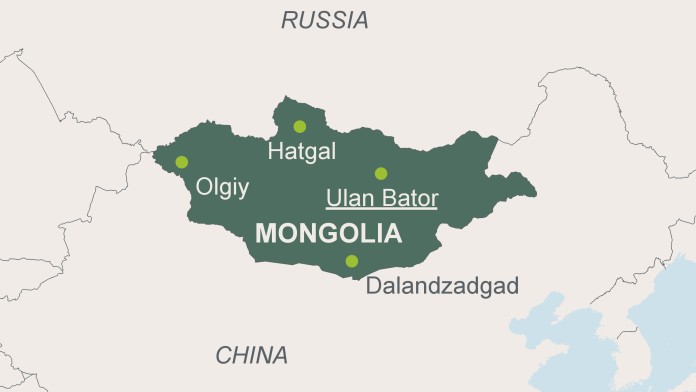
As of: 05/2021
Mongolia’s diverse ecoregions provide habitats for a wide range of plant and animal species. Biodiversity risks are posed by factors such as rising numbers of livestock and the resulting overgrazing, mining, unregulated logging and climate change, which has a major impact on Mongolia. Even though the formal legal requirements for protected area management are established by national legislation and the ratification of international conventions, the system of protected areas in Mongolia suffers from severe underfunding. This is where KfW’s involvement starts with Phases I–III of the programme “Biodiversity and adaptation to climate change in Mongolia”.
| Project title | Biodiversity and adaptation to climate change (Phases I–III) |
|---|---|
| Commissioned by | German Federal Ministry for Economic Cooperation and Development (BMZ) |
| Country/Region | Mongolia |
| Project partners | Ministry of Environment and Tourism |
Mongolia is rich in natural diversity with various ecosystems and a high degree of biodiversity. The country has different ecoregions with distinctly continental to boreal climate conditions – from forest regions (taiga) in the north, steppes and grassland ecosystems, to semi-deserts and deserts in the south and southwest of the country. Due to this natural diversity and the country's low population density, Mongolia is a refuge for flora and fauna in the Central and East Asia region, including many endangered species. However, climate change coupled with the lack of sustainable forms of land use, combined with insufficient protection of important ecosystems, negatively impact the country’s biodiversity. The distribution ranges of several species have already shifted northwards or to higher mountainous areas. At the same time, these factors affect the means of subsistence of the rural population, which has lived from natural resources for centuries.
In recent years, however, environmental policy reforms have significantly improved the conditions for protecting Mongolian biodiversity.
With the planned designation of almost 30% of the country’s territory as protected areas (a total of 465,000 km²), Mongolia is underscoring its commitment to nature conservation and the implementation of the UN Convention on Biological Diversity.
It is, however, an enormous task as the area to be protected is approx. 16.6 ha per inhabitant (compared to Germany: 0.016 ha per inhabitant). Grants from the national budget are usually the only source of income for the protected areas, but more than 90 percent of this income is used for employee salaries. In this respect, there is a considerable need for investment in improved management planning and protected area infrastructure to ensure that the country’s nature conservation goals are ultimately achieved.
On behalf of the German Federal Government, KfW is providing a grant of EUR 39 million (Phases I–III) to support improved protected area management in Mongolia with due consideration for climate change and at the same time stabilising or improving the living conditions of local residents. The geographical focus of the project so far has been on the north, east and central Mongolia (Phase I). In Phases II and III, which recently got underway, the focus is on the west and southwest of the country. The primary target group in all three phases is the rural population living in and around the protected areas, i.e. the people living in the peripheral zones of the protected areas and the ecological corridors. About one third of the target group lives in poor, traditional conditions, often as nomads, following forage for their animals, and is heavily dependent on the use of natural resources.
Phase I includes the following components: government protected areas and zones within the government’s responsibility, municipal protected areas and ecological corridors are supported in management and business planning (component 1) and can then qualify for the financing necessary to implement the plans via a competition-based selection mechanism (component 2). Sectoral investments spanning protected areas aim to boost steering and implementation capacities in the Ministry for Environment and Tourism (component 3). Training measures, support for scientific cooperation and contributions to policy dialogue are embedded in component 4.
The measures financed so far include the following: creation and implementation of management plans as well as tourism management plans in selected protected areas and neighbouring areas, data collection to measure management effectiveness, supply of key equipment for the effective management and monitoring of the protected areas (including cameras, binoculars, equipment for rangers, off-road vehicles, motorcycles, fire-fighting vehicles and fire-fighting suits, IT equipment, etc.). Various construction measures were also financed (ranger housing, information centres, administration buildings, training centres).
The components of Phases II and III are based on those of Phase I.
The FC programme supports the Mongolian Ministry of the Environment in implementing the Sustainable Development Goals (SDGs, particularly SDG 15: “Protect, restore and promote the sustainable use of terrestrial ecosystems, sustainably manage forests, combat desertification, and halt and reverse land degradation and halt biodiversity loss”). It promotes the introduction of sustainable protection and use concepts in and around the Mongolian protected areas included in the project. It thus helps to mitigate the core problem, namely the increasing threat and simultaneously diminishing adaptability of valuable natural ecosystems to climate change. The impacts of the programme are measured in terms of the management efficiency of the supported protected areas, the proportion of effectively protected grassland or sustainably managed forest area, the population size of selected key species and the house-hold income of the local population.
The project contributes to the achievement of these following United Nations Sustainable Development Goals: